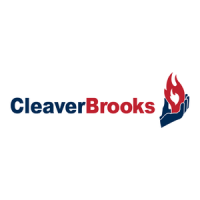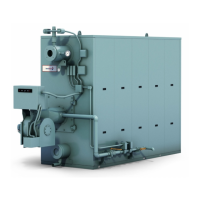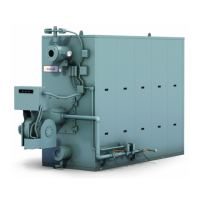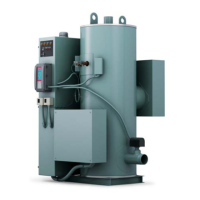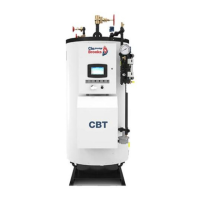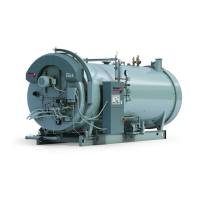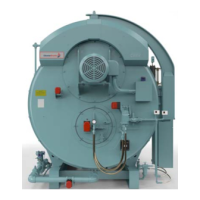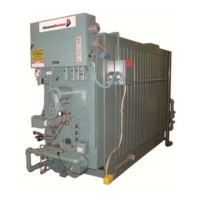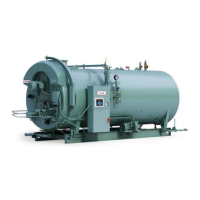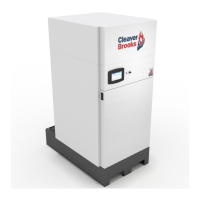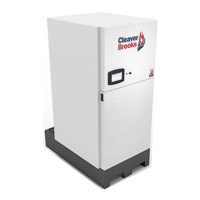Adjustment Procedures Chapter 5
750-177 5-7
Pressure Correction
The flow rate outlined in Section P is based on a “base”
pressure, which is usually atmospheric or 14.7 psia.
Meters generally measure gas in cubic feet at “line” or supply
pressure. The pressure at which each cubic foot is measured
and the correction factor for the pressure must be known in
order to convert the quantity indicated by the meter into the
quantity which would be measured at “base” pressure.
To express the volume obtained from an actual meter reading
into cubic feet at base pressure, it is necessary to multiply the
meter index reading by the proper pressure factor obtained
from Table 6-2
As An Example:
Assume that a 500Flextube boiler is rated for 5MMBtu/hr
input is installed and equipped with a standard gas train; and
that 1,000 Btu natural gas is available with an incoming gas
pressure of 3 psig. The flow requirements can be determined
as follows:
Flow
Since the gas flow rate is based on standard conditions of
flow, correction must be made for the supply pressure through
the meter of 3 psig. Determine the flow rate by dividing the
Btu content of the gas into the burner input (Table 6-1) and
“correct” this answer by applying the correction factor for 3
psig (Table 6-2).
Btu/hr Input
= CFH (Cubic feet/hour) Required
Btu/cu-ft
OR
5,000,000
= 5,000 CFH (At 14.7 Ib-atmospheric base
1,000 pressure)
THEN
5,000
= 4237 CFH
1.18
This is the CFH (at line pressure) that must pass through the
meter so that the equivalent full input requirement of 5,000
CFH (at base pressure) will be delivered.
Checking Gas Flow
Your gas supplier can generally furnish a gas meter flow chart
from which gas flow can be determined. After a short
observation period, the information aids in adjusting the
regulator to increase or decrease flow as required to obtain the
rating.
Final adjustment of the gas fuel is carried out by means of
Fine tuning the linkage adjustments, while performing a
combustion efficiency analysis. See Section O for details.
Note: The information given in this section
is for all practical purposes sufficient to set
and adjust controls for gas input. Your gas
supplier can, if necessary, furnish exact
correction factors that take into
consideration Btu content, exact base
pressure, specific gravity, temperature, etc.,
of the gas used.
P. GAS FUEL COMBUSTION
ADJUSTMENT
After operating for a sufficient period of time to assure a
warm boiler, adjustments should be made to obtain efficient
combustion.
Burner efficiency is measured by the amount or percentage of
O
2
present in the flue gas. O
2
readings determine the total
amount or excess air in the combustion process, above the
point of stoichiometric combustion or perfect combustion.
Stoichiometric combustion is a term used to describe a
condition when there is the exact amount, molecule for
molecule, of air for the fuel attempting to be burned. This can
be accomplished under laboratory conditions, however it’s
not practical to attempt to meet this condition in a boiler.
Stoichiometric combustion however, is the reference point
used when setting fuel/air ratios in a boiler.
There must always be excess air in the combustion process to
account for changes in boiler room temperature and
atmospheric conditions, and to ensure the combustion is on
the proper side of the combustion curve.
Proper setting of the air/fuel ratios at all rates of firing must
be established by the use of a combustion or flue gas analyzer.
The appearance or color of the gas flame is not an indication
of its efficiency, because an efficient gas flame will vary from
transparent blue to translucent yellow.
Most flue gas analyzers in use today measure the content, by
percentage of oxygen (O
2
) and carbon monoxide (CO) either
by percent or parts per million (ppm). Carbon dioxide (CO
2
)
is not normally measured with todays flue gas analyzers, but
may be displayed via a calculation.
The O
2
levels through the entire firing range of the burner,
low fire to high fire should be tested. Cleaver-Brooks
recommendations on turndown should also be followed and
the turndown range of the burner should not be exceeded.
It’s important to understand what the readings shown on an
instrument refer to when setting combustion in a boiler. To
assist with this understanding Figure 5-5 shows the
relationship between O
2
levels (excess air) and the products
of combustion for a typical flue gas analysis (natural gas).
One of the products of combustion is CO
2
(Carbon Dioxide).
This is shown in percentage.
Another product of combustion is CO (carbon monoxide) and
is shown in both percentage and parts per million (ppm). The
